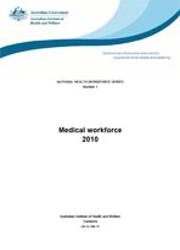Summary
This report presents information on the medical practitioner workforce, based primarily on estimates derived from the National Health Workforce Data Set: medical practitioners 2010, the first in this new series. The data set contains information on the demographic and employment characteristics of medical practitioners who were registered in Australia in 2010. Data are collected via registration forms and a survey instrument administered by the Australian Health Practitioner Regulation Agency, in conjunction with the annual registration renewal process. Registered medical practitioners whose principal state of practice was Queensland or Western Australia have largely been excluded from this report (unless stated otherwise), because registration renewal in these states did not close until after the national registration deadline of 30 September 2010.
The main findings of the report are:
- In 2010, the total number of medical practitioners registered in Australia was 81,639.
- Between 2006 and 2010, the number of medical practitioners employed in medicine, in all states and territories other than Queensland and Western Australia, increased by 13.3% from 46,336 to 52,497. In 2010, 93.6% (49,128) were working as clinicians, of whom 36.1% were specialists and 35.3% were general practitioners. The largest main speciality of practice identified by respondents was physician (22.1% of all specialists), followed by surgery (14.7% of all specialists).
- Of those employed as non-clinicians (6.4% of all employed medical practitioners), almost a third were researchers (30.8%) and a quarter were administrators (24.9%).
- The average weekly hours worked by employed medical practitioners decreased slightly from 43.5 hours in 2006 to 43.3 hours in 2010. Over the same period, average hours worked by males also decreased slightly (46.4 to 46.2 hours), while hours worked by females increased (37.8 to 38.5 hours).
- Despite a slight decrease in average hours worked from 2006 to 2010, the overall supply of employed medical practitioners increased from 346 to 366 full-time equivalent medical practitioners per 100,000 population over that period due to overall numbers increasing by 13.3%.
- Medical practitioner supply across remoteness areas ranged from 400 full-time equivalents per 100,000 population in Major cities to 185 in Outer regional areas. In contrast, the variation in the supply of general practitioners was smaller between Major cities and Outer regional areas (105 and 103 full-time equivalents per 100,000 population, respectively).
- The average age of medical practitioners did not change from 2006 to 2010 (45.9 years). However, the proportion of employed medical practitioners aged 55 and over increased from 25.5% to 26.4% over the same period.
- Females continued to increase their share of the medical practitioner workforce, growing to 37.0% of employed practitioners in 2010 (up from 33.7% in 2006). Among clinicians, in 2010, females accounted for 49.2% of hospital non-specialists compared with 25.4% of specialists.
- The survey response rate of 78.0% in 2010 is the highest since 1999. Estimates should be interpreted with caution, especially due to the exclusion of Queensland and Western Australia from the figures in this report.



